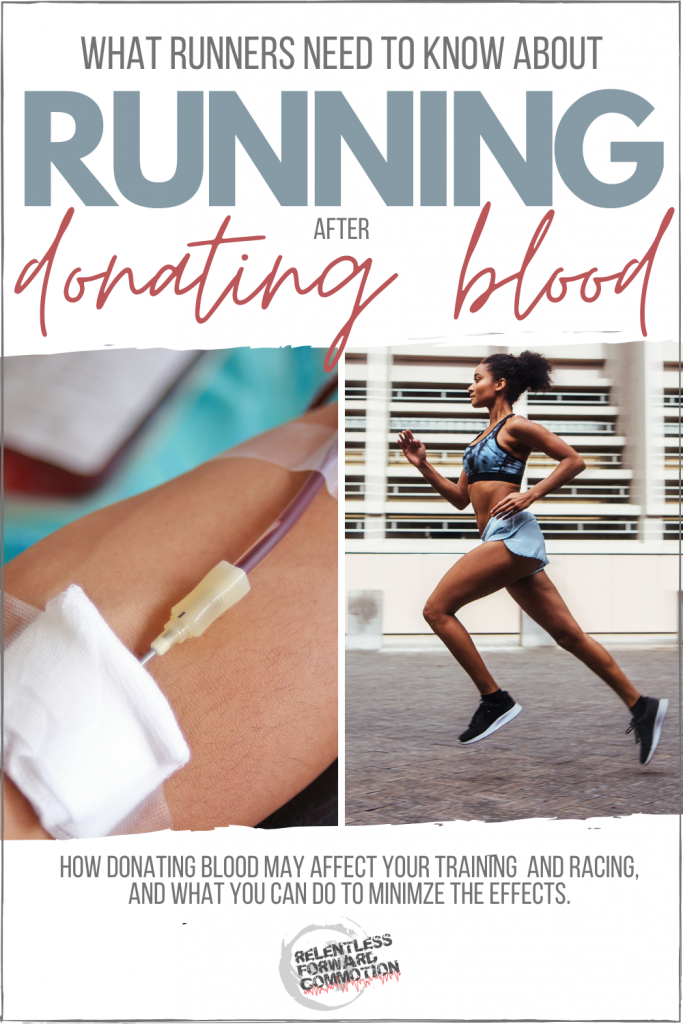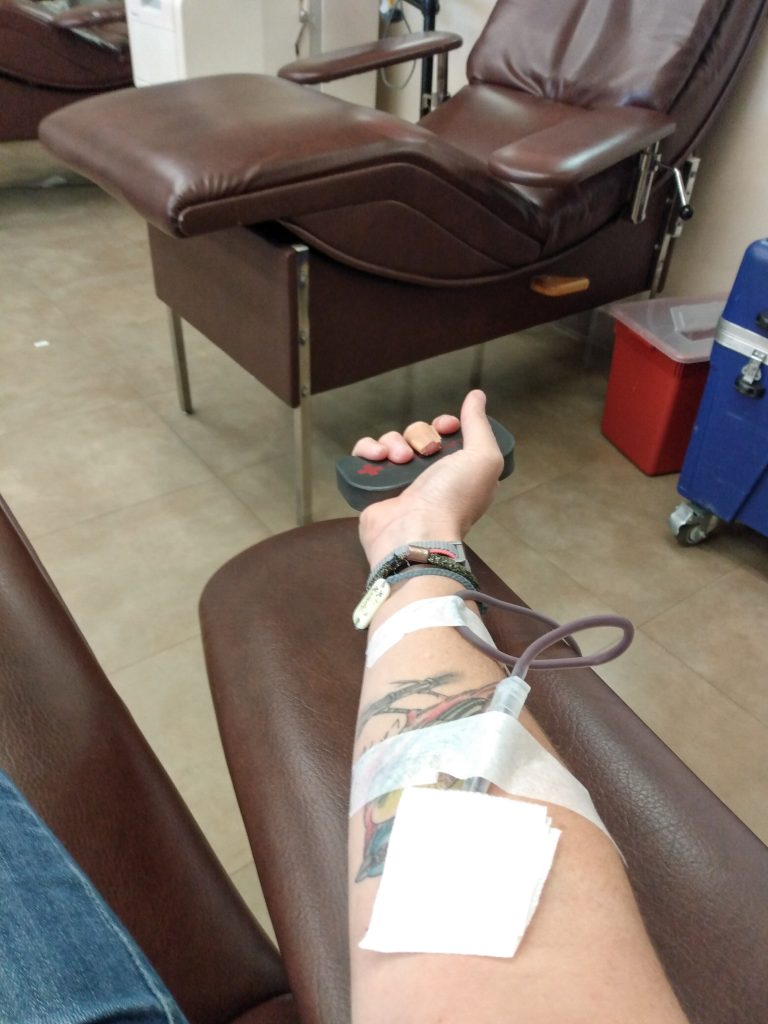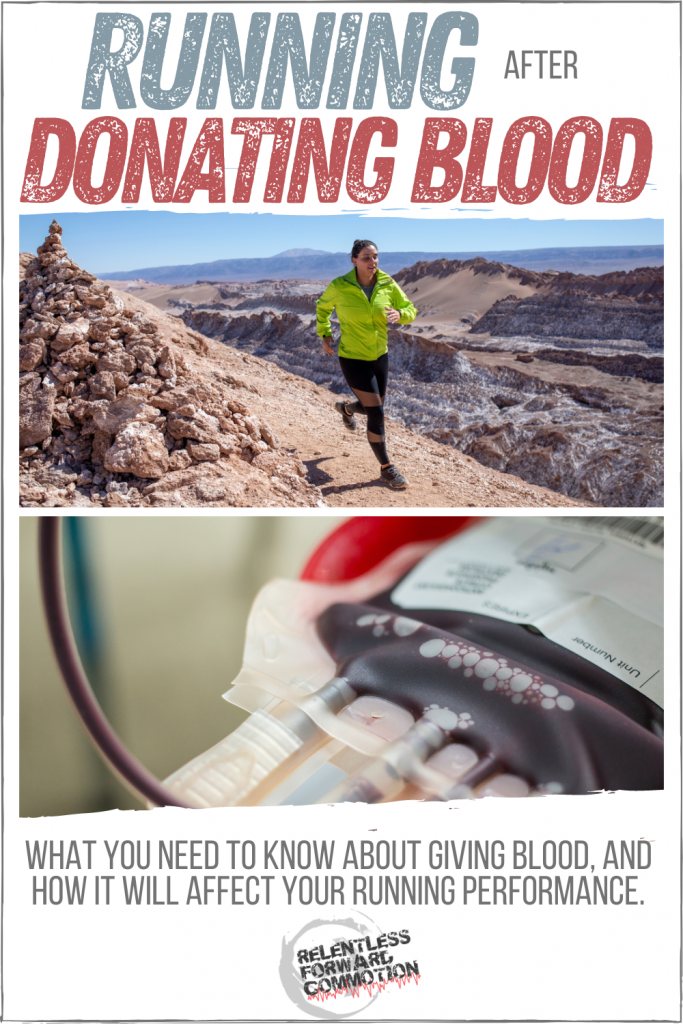what happens to your body after blood donation
Last Updated on December 23, 2020 by
Confession: I put off altruistic blood for the concluding decade because I was concerned information technology would negatively affect my running and racing. And bluntly, I could never find a window of opportunity where preparation or racing wasn't a concern.
But at some point this summer, when training and racing wasn't a concern (cheers 2020), I decided to quit being so selfish and to get donate. In doing so, I did a lot of enquiry about running after donating blood, and more importantly, I experienced running after giving blood.
And guess what? It wasn't as huge of a deal equally I anticipated.
That said, altruistic blood CAN accept an impact on your running, so it'due south important to understand how and why, so y'all tin plan appropriately.

What Runners Need to Know about Giving Claret
In society to all-time understand how donating blood affects your running, we've got to first understand exactly what part claret plays in our body. Yep that's right, I'1000 virtually to dive into some beefcake and physiology – one of my favorite things to do around here. So allow's start with a brief refresher, and stick with me, we'll answer the question of how blood donation affects your running soon enough.
How Blood Works
Blood is responsible for transporting oxygen and nutrients around the body, and also for transporting cellular waste product to the lungs, kidneys, and digestive system to exist removed from the body. Oxygen is a necessary component of cellular respiration, which is the process past in which our bodies break downward sugar (from the foods y'all eat) and plow it into adenosine triphosphate (ATP). Recall of ATP equally the torso's useable course of energy. ATP is and then used to perform work at the cellular level (i.east. "exercise" all of the things your body needs to exercise to continue living).
In brusk, we NEED oxygen to function. And runners rely on this process e'er more, as the act of running places a greater demand for oxygen on our bodies.
So what is blood made of? Blood consists of approximately 55% plasma, and the other 45% is made up of red blood cells, leukocytes, and platelets.

Plasma
Plasma is essentially the "liquid" portion of your blood. It'south primary purpose is to exist the transport system for blood cells, and information technology plays a critical office in maintaining normal blood pressure. Plasma consists of 92% water, and the remaining 8 percent consists of carbon dioxide, glucose, hormones, proteins, vitamins, fats, and mineral salts.
Crimson Blood Cells
Cherry blood cells (besides referred to every bit RBCs, or erythrocytes) contain hemoglobin, the poly peptide that binds to and carries oxygen throughout your trunk.
White Blood cells
Likewise know as leukocytes (or WBCs), these cells are responsible for fighting germs and making antibodies. Blood contains far fewer WBCs than red blood cells, although the body can increase WBC product to fight infection.
Platelets
Also called thrombocytes, platelets are responsible for the clotting process inside the body. When an injury occurs, platelets work with proteins called clotting factors to command and stop bleeding.
Types of Claret Donations
Altruistic blood is exactly what it sounds like: a needle is placed into a vein in your arm, and blood is removed. While that sounds – uncomfortable – whole blood donation is actually a quick and painless process.

According to the American Cerise Cross, at that place are four types of blood donations.
- Whole Blood Donation: whole blood (typically a pint per donation) is removed from the donor. This is the nigh common type of claret donation, and removes your red blood cells, white claret cells, platelets, and plasma.
- Power Red Donation: As well referred to equally "double red", this type of donation is where cherry-red blood cells are separated from the other blood components, and so your plasma and platelets is returned dorsum to you. This results in donating a more concentrated amount of cherry blood cells compared to a whole blood donation.
- Platelet Donation: an apheresis machine collects your platelets along with some plasma, returning your reddish cells and well-nigh of the plasma dorsum to you.
- Plasma Donation: Plasma is collected through an automated process that separates plasma from other blood components, then returns your cherry-red blood cells and platelets to you.
Running After Donating Blood
Now that nosotros've done an "anatomy and physiology 101" lesson regarding claret and blood donation (thanks for sticking with information technology), let's talk nearly what happens to your trunk after you donate blood. And more importantly, what to expect when running afterward altruistic blood.

What Happens After Yous Donate Blood
Allow's assume you've donated a pint of whole claret, as this is the most mutual type of donation. You are now down – yous guessed it – one whole pint of blood. For reference, on average there are:
- about 9 pints (iv.3 liters) of claret in an boilerplate-sized female (five anxiety five inches tall and weighing 165 pounds)
- almost 12.ii pints (five.7 l) in an average-sized male (half dozen feet in top and weighing 200 pounds)
(Sharma R, Sharma S. [Updated 2020 Apr 25])
So on average, y'all are downwards nearly 10% blood book after a standard whole blood donation. Now afterward you donate, your trunk gets to work to rapidly replace what was lost. The first thing it does is replace plasma levels, to assist stabilize your blood force per unit area. This happens within hours, and is unremarkably complete within 24 hours mail service donation.
Next, your platelet and white blood jail cell numbers begin to climb, returning to normal over the form of a few days.
Red blood cells, however, have longer to replace. It can accept upward to 6 to 12 weeks before RBCs are back to their previous levels.

How Does This Touch on My Running?
At this point, I hope our anatomy lesson has clicked, and you're already figuring out how donating whole blood can affect your running. Subsequently whole blood or double carmine donation, you have a lower volume of scarlet claret cells, which too means a lower hemoglobin count. Lower hemoglobin equals reduced oxygen carrying capacity to your muscles.
In layman'due south terms: running subsequently donating blood is going to feel more than difficult.
But how much harder, and how long does this side effect last? There'south a lot of varying research. For case:
- One written report using fourth dimension to exhaustion on cycle ergometer tests demonstrated that VO2max (the maximum amount of oxygen your body can accept in and apply during exercise) dropped by 15% and time to exhaustion decreased by 19% during the do test two hours subsequently a claret donation. VO2 max was still ten% and seven% lower than pre-donation levels at two and seven days mail-donation. (Hill, Vingren, Burdette, 2017)
- Another study focusing on female person donors, found that meridian oxygen uptake in women remained lower for upwardly to 28 days after blood donation. (Stangerup, I., et al, 2017) The slower recovery of functioning in women is likely due to catamenia, which can also negatively affect hemoglobin levels. (Ofojekwu et al, 2013)
- What's more, information technology appears that echo donations tin have a greater detriment to your running. Studies prove that 25-35 percent of regular donors develop atomic number 26 deficiency. Since iron is needed for reddish claret cell product, low iron can cause fatigue and anemia, a condition in which the claret has a lower than normal number of red blood cells, and can take many months to recover from.
Ultimately what you need to empathise is that donating claret will lower your oxygen conveying capacity temporarily, thus making running experience harder. How long that effect lasts, and to what extent it is really felt, varies from person to person, and may fifty-fifty vary from donation to donation.
What almost Plasma or Platelet Donation?
Because plasma and platelet donation both return red claret cells back to your torso during the donation process, any negative effects due to loss in hemoglobin in standard whole blood or double ruddy donation exercise not utilise here.
When donating plasma, running can be effected up of 24-72 hours, until plasma levels stabilize. Studies bear witness that the fourth dimension to exhaustion for those who donated plasma (equally opposed to whole blood) was back to their baseline afterward just two days (Hill, Vingren, Burdette, 2017).
The recovery fourth dimension for donating platelets is less than whole claret, but it's probably best to donate platelets in the beginning of your training season or when you know you'll be able to take a small interruption.
How Can I Minimize the Furnishings of Donating Blood on my Running?
Hopefully all of the above information didn't completely scare you out of donating blood. Because here's the thing: blood donation is incredibly of import. It'due south estimated that every year in the U.s.a., 4.5 million people will demand a blood transfusion. Even so only 37 percent of the country's population is able to donate blood. And then if you are able to donate, it's a great and selfless thing to consider doing.
You can minimize the effects of donating claret on your running past taking the following steps:
Programme to donate during off season, or early on in a grooming cycle
Since there'southward no denying blood donation can affect your running, programme to donate either during off flavour, when running goals are not as imperative, or early on in your training bike, when volume and endeavour is withal on the lower end. If y'all have a goal race coming up, program to donate at least 4 weeks before (to let hemoglobin levels to render to normal), or 4 weeks after (to let your allowed organisation to recover before donation) your race
Programme Your Training Week Around Your Donation.
Plan to donate on a balance day. Further, plan to follow your donation with several days of curt, piece of cake effort workouts. When you exercise return to running, try to train by perceived endeavour for the first calendar week or so, rather than stressing over pace.

Hydrate
As we've discussed, claret is made up of 55% plasma, and plasma consists of 92% water. Staying hydrated before and after blood donation will help prevent your claret pressure from dropping too low, and will help stimulate the mail service donation increase in plasma levels.
Nutrition
Prior to, and afterwards donation, brand certain your diet includes plenty of healthy, iron rich foods. The atomic number 26 will help your body with hemoglobin production. Examples include: spinach, scarlet meat, fish, poultry, beans, and atomic number 26-fortified cereals.
Iron Supplementation
A 2012 NHLBI-supported study measured the effect of low dose daily iron supplementation on the fourth dimension to recovery of lost hemoglobin and iron after donating a unit of blood. Compared to donors who did not have iron, the donors taking iron supplements returned to pre-donation hemoglobin levels faster in both the lower iron (5 weeks versus 23 weeks) and higher iron groups (iv weeks versus 11 weeks).
Similarly, donors taking iron supplements recovered lost fe more apace than those not receiving supplements (11 weeks versus more than 24 weeks). Without iron supplementation, 2 thirds of the donors did not recover the iron lost from donating blood after 24 weeks.
Every bit always, please check with your doc kickoff to meet if you are a candidate for fe supplementation, as over ingesting atomic number 26 tin come with health risks.
Avoid running 24 hours mail donation
Because plasma levels are low, causing lower blood pressure, running immediately or within hours after donation can cause dizziness or even fainting. Further, harder intensity workouts may increase the take chances of excessive haemorrhage from the area where the needle enters your skin. Therefore, the American Red Cantankerous recommends waiting to do until your plasma levels normalizes (approximately 24-72 hours).
Ultimately, blood donation is a personal determination for runners.
Personally, I practise not regret altruistic blood. If anything, I regret waiting so long to sign upwards. While I have certainly experienced a little more sluggishness in my runs immediately post donation, overall, I haven't noticed a huge impact on my running. Just then again, I'm not training for the Olympic trials, or annihilation where a slight decrease in performance will ruin my plans.
Blood donation is an important, selfless gift. Yet, as mentioned above, not everyone is a great candidate for giving blood (you tin read about some of the blood donation requirements HERE). If you're not certain if blood donation is right for you lot or your body, or y'all take added concerns almost recovering from claret donation, talk with your doctor first.
Source: https://relentlessforwardcommotion.com/running-after-donating-blood/
0 Response to "what happens to your body after blood donation"
Post a Comment